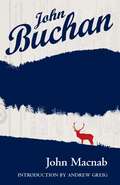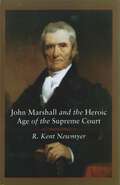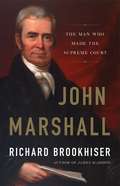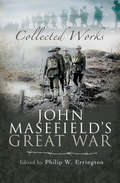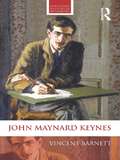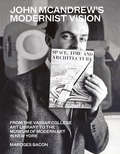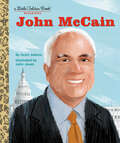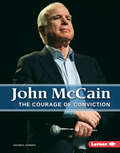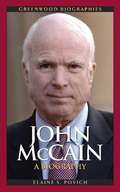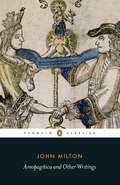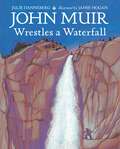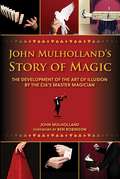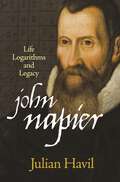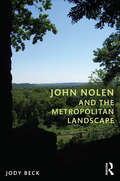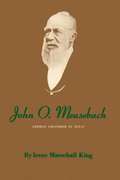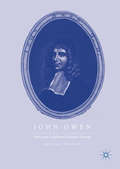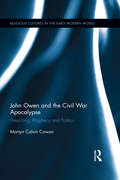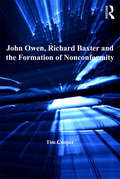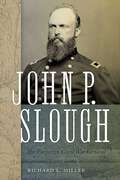- Table View
- List View
John Macnab
by John Buchan Andrew GreigIn 1925, John Buchan published his second most famous novel, "John MacNab"; three high-flying men -- a barrister, a cabinet minister and a banker -- are suffering from boredom. They concoct a plan to cure it. They inform three Scottish estates that they will poach from each two stags and a salmon in a given time. They sign collectively as 'John McNab' and await the responses. This novel is a light interlude within the "Leithen Stories" series - an evocative look at the hunting, shooting and fishing lifestyle in Highland Scotland.
John Marshall and the Heroic Age of the Supreme Court (Southern Biography Series)
by R. Kent NewmyerJohn Marshall (1755--1835) was arguably the most important judicial figure in American history. As the fourth chief justice of the United States Supreme Court, serving from 1801 to1835, he helped move the Court from the fringes of power to the epicenter of constitutional government. His great opinions in cases like Marbury v. Madison and McCulloch v. Maryland are still part of the working discourse of constitutional law in America. Drawing on a new and definitive edition of Marshall's papers, R. Kent Newmyer combines engaging narrative with new historiographical insights in a fresh interpretation of John Marshall's life in the law. More than the summation of Marshall's legal and institutional accomplishments, Newmyer's impressive study captures the nuanced texture of the justice's reasoning, the complexity of his mature jurisprudence, and the affinities and tensions between his system of law and the transformative age in which he lived. It substantiates Oliver Wendell Holmes Jr.'s view of Marshall as the most representative figure in American law.
John Marshall: The Man Who Made the Supreme Court
by Richard BrookhiserThe life of John Marshall, Founding Father and America's premier chief justice In 1801, a genial and brilliant Revolutionary War veteran and politician became the fourth chief justice of the United States. He would hold the post for 34 years (still a record), expounding the Constitution he loved. Before he joined the Supreme Court, it was the weakling of the federal government, lacking in dignity and clout. After he died, it could never be ignored again. Through three decades of dramatic cases involving businessmen, scoundrels, Native Americans, and slaves, Marshall defended the federal government against unruly states, established the Supreme Court's right to rebuke Congress or the president, and unleashed the power of American commerce. For better and for worse, he made the Supreme Court a pillar of American life. In John Marshall, award-winning biographer Richard Brookhiser vividly chronicles America's greatest judge and the world he made.
John Masefield's Great War: Collected Works
by John MasefieldJohn Masefield wrote four books on The Great War: Gallipoli, The Old Front Line, War and the Future and Battle of the Somme. These have been acclaimed as perceptive and beautiful crafted works, which bring home the full horror and hopelessness of war. This is the first opportunity for historians and general readers to purchase all four in a handsome yet reasonably priced volume, which is definitely a collectable. In addition there is a full introduction by Dr. Philip Errington, the leading Masefield authority who is head of Sotheby's Department of Printed Books and Manuscripts. This rare collection is rounded off by a selection of shorter pieces by the hugely popular Poet Laureate.
John Maynard Keynes (Routledge Historical Biographies)
by Vincent BarnettJohn Maynard Keynes is arguably the most important and influential economist of the twentieth century, and stands alongside Adam Smith and Karl Marx as one of the most famous economic thinkers of all time. Keynes’s radical reassessment of the accepted principles of economics led to new ways of thinking about how to deal with financial crises and economic depressions, and encouraged governments to increase levels of state investment to create economic growth. This historical biography shows how Keynes was more than an academic theorist and how his policy proposals had a significant impact on the economic and financial architecture of many Western countries from the 1920s onward, and on the post-war international financial system. It also tells the story of his colourful private life - Keynes was an active member of the Bloomsbury group of artists and intellectuals, he entertained various ‘secret’ male lovers in his youth, he married a famous Russian ballerina in 1925 and he was also an astute collector of fine art and antiquarian books. Vincent Barnett emphasizes the relationship between the personal and professional by presenting the book chapters in pairs, examining first the central features of Keynes’s life, personal development and policy ideas over the period in question, and then the theoretical content of his major writings from the same period. Barnett argues controversially that allowing psychology a much greater role within economics was a main but often-neglected feature of The General Theory of Employment, Interest and Money, and that Keynes’s policy writings were more concerned with the Britain’s national interest than is sometimes recognised. The result is a concise new biography that is both intellectually rigorous and easily accessible to students and anyone else seeking to understand the life and work of England‘s foremost economist.
John McAndrew's Modernist Vision: #N/A
by Mardges BaconJohn McAndrew's Modernist Vision tells the compelling story of the architect, scholar, and curator John McAndrew, who played a key role in redefining modernism in the United States from the 1930s onward. The designer of the Vassar College Art Library—arguably the first modern interior on a college campus—and the curator of architecture at the Museum of Modern Art in New York from 1937 to 1941, McAndrew was instrumental in creating a distinct and innovative aesthetic that bridged the European modernist lineage and American regional vernacular. Providing a fascinating glimpse into McAndrew's life, his associations with important architects and artists, and the historical context that shaped his work, this book is a thoroughly researched testament to a man who left a powerful mark on the evolution of American architecture.
John McCain: A Little Golden Book Biography (Little Golden Book)
by Gram AdamsHelp your little one dream big with a Little Golden Book biography that's all about Senator John McCain! It's the perfect introduction to nonfiction for preschoolers.This Little Golden Book about John McCain--the Vietnam war veteran, six-term U.S. senator from the state of Arizona, and Republican presidential nominee—is an inspiring read-aloud for young girls and boys.Look for more Little Golden Book biographies: • Misty Copeland • Frida Kahlo • Iris Apfel • Bob Ross • Queen Elizabeth II • Harriet Tubman
John McCain: An American Hero
by Beatrice GormleyLearn all about the life of Senator John McCain in this enlightening biography specially written for a younger audience. Five-term Arizona senator John S. McCain’s indelible mark on America was perhaps his destiny, as his grandfather proclaimed when he was just an infant, “This boy has the stamp of nobility on his brow.” <P><P> Following both his four-star US Navy father and grandfather into military service, McCain’s naval career imprinted the code of honor he has maintained to this day. Throughout the myriad life and death perils he faced—most notably being held captive as a Vietnam War prisoner of war for five and one half years in the Hoa Lo Prison or ‘Hanoi Hilton’—his courage, bravery, and tenacity has served him time and time again: as Navy liaison to the US Senate, as a member (and then chairman) on the Armed Services Committee, Commerce Committee, and Indian Affairs Committee, playing a key role in restoring diplomatic relations with Vietnam, championing finance reform by sponsoring the McCain-Feingold Act, and as the Republican nominee for president in 2008. <P><P> Beatrice Gormley’s enriching biography tells the riveting story of one of America’s last, great, enduring heroes.
John McCain: The Courage of Conviction (Gateway Biographies Ser.)
by Heather E SchwartzThis timely title examines the remarkable life and death of John McCain, from his time as a decorated war veteran to elder statesman. Accessible text and plentiful photos cover McCain's early life, his military career, his political legacy, and his 2017 diagnosis of brain cancer. Up-to-the-minute details round out this latest look at a uniquely American figure.
John Mccain: A Biography
by Elaine S. PovichJohn McCain's "maverick" streak and military-forged code of honor have coexisted uneasily at times with the demands of his political career and his determined pursuit of the presidency.
John Mcgraw
by Charles AlexanderSpanning forty years from the 1890s to the post-World War I decade is this life story of one of baseball's most charismatic, competitive, and savvy players--and the most accomplished manager the game has ever known. 8-page photo insert.
John Milton: Areopagitica and Other Writings
by John Milton William PooleJohn Milton was celebrated and denounced in his own time both as a poet and as a polemicist. Today he is remembered first and foremost for his poetry, but his great epic Paradise Lost was published very late in his life, in 1667, and in his own time most readers more readily recognized Milton as a writer of prose. This superbly annotated new book is an authoritative edition of Milton’s major prose works, including Of Education, The Tenure of Kings and Magistrates, and the Divorce tracts, as well as the famous 1644 polemical tract opposing licensing and censorship, Areopagitica. For more than sixty-five years, Penguin has been the leading publisher of classic literature in the English-speaking world. With more than 1,500 titles, Penguin Classics represents a global bookshelf of the best works throughout history and across genres and disciplines. Readers trust the series to provide authoritative texts enhanced by introductions and notes by distinguished scholars and contemporary authors, as well as up-to-date translations by award-winning translators.
John Muir Wrestles a Waterfall
by Julie DannebergThe now iconic figure John Muir, while living at the base of Yosemite Falls in California, ventures up the trail from his cabin one night and has a harrowing waterfall adventure. Back matter roots the story in Muir’s life’s work as a conservationist and naturalist.
John Mulholland's Story of Magic: The Development of the Art of Illusion by the CIA's Master Magician
by John MulhollandMagic has entranced public forums for hundreds of years, predating many other forms of entertainment that we enjoy today. This ancient art, with its captivating illusions and seemingly impossible sleight of hand, is still as relevant today as ever. Originally published in 1935, master magician John Mulholland’s Story of Magic is a delightful tour through the progression of magic, from its origin to the book’s contemporary period. It offers insights and reflections on famous routines and tricks, black-and-white photographs and illustrations to give readers visual reference, as well as informative facts that weave together a timeline of events for those interested in the history of magic. With a brand-new foreword written by renowned master magician and historian Ben Robinson, this timeless classic will enchant readers and educate them on the art of magic.
John Napier: Life, Logarithms, and Legacy
by Julian HavilThe most comprehensive account of the mathematician's life and workJohn Napier (1550–1617) is celebrated today as the man who invented logarithms—an enormous intellectual achievement that would soon lead to the development of their mechanical equivalent in the slide rule: the two would serve humanity as the principal means of calculation until the mid-1970s. Yet, despite Napier's pioneering efforts, his life and work have not attracted detailed modern scrutiny. John Napier is the first contemporary biography to take an in-depth look at the multiple facets of Napier’s story: his privileged position as the eighth Laird of Merchiston and the son of influential Scottish landowners; his reputation as a magician who dabbled in alchemy; his interest in agriculture; his involvement with a notorious outlaw; his staunch anti-Catholic beliefs; his interactions with such peers as Henry Briggs, Johannes Kepler, and Tycho Brahe; and, most notably, his estimable mathematical legacy.Julian Havil explores Napier’s original development of logarithms, the motivations for his approach, and the reasons behind certain adjustments to them. Napier’s inventive mathematical ideas also include formulas for solving spherical triangles, "Napier’s Bones" (a more basic but extremely popular alternative device for calculation), and the use of decimal notation for fractions and binary arithmetic. Havil also considers Napier’s study of the Book of Revelation, which led to his prediction of the Apocalypse in his first book, A Plaine Discovery of the Whole Revelation of St. John—the work for which Napier believed he would be most remembered.John Napier assesses one man’s life and the lasting influence of his advancements on the mathematical sciences and beyond.
John Nolen and the Metropolitan Landscape
by Jody Beck"A model city, the hope of democracy" – John Nolen on his suggested plans for Madison, Wisconsin This book connects John Nolen's political and social visions with his design proposals by analyzing his extensive writings, personal correspondence and some of his most significant works. While John Nolen is best known as a city planner, he trained as a landscape architect and used the titles 'landscape architect' and 'city planner' interchangeably throughout his career. A prolific practitioner, he was engaged in nearly 400 projects throughout the United States between 1905 and 1936, including town planning, industrial housing, state and city parks, new towns and regional planning. Focusing particularly on several projects central to Nolen’s career including Madison (WI), Mariemont (OH), Venice (FL) and Penderlea (NC), Beck investigates the ideologies that underpinned Nolen’s work. This is a rare look at a key figure in the development of 20th century American cities.
John O. Meusebach: German Colonizer in Texas
by Irene Marschall KingOtfried Hans Freiherr von Meusebach chose a life of hardship and freedom in Texas rather than a life of comfort and influence in his native Germany, where he had lived his formative years within a framework of unconstitutional government. In 1845 the young liberal relinquished his hereditary German title, left behind his close family ties and his various intellectual and political associations, and arrived in Texas as John O. Meusebach, commissioner-general for the Society for the Protection of German Immigrants. His background enabled him to assume an enlightened leadership of fellow immigrants who were pouring in from Germany. Lacking adequate financial backing, he nevertheless led the settling of some five thousand people in a land that was largely occupied by Indians. Irene Marschall King presents the full sweep of Meusebach's vigorous life: Meusebach as the young liberal in Germany, as the colonizer in the 1840s, as a Texas senator and, later, an observer of the Civil War, and as a Texan who devoted his later years to bringing the Texas soil to fruition-all set against a background of the immigration movement and frontier life. "Freedom is not free; it is costly," Meusebach believed. In Texas he found for himself and others freedom worth the price he paid. Rich in historic detail, King's story recounts the founding of Fredericksburg, the crippling effect of the Mexican War upon the mass of immigrants huddled in illness on the coast, the signing of the Indian Treaty, which opened to settlement over three million acres of land, and the final collapse of the Society for the Protection of German Immigrants. Also depicted is the colonists' influence on the land-the gardens and orchards of south central Texas, the "Easter Fires" that blaze on the hills surrounding Fredericksburg, the mixture of German custom with American necessity that created a unique culture. Throughout the narrative Mrs. King presents a fascinating cast of characters: the noble Prince Solms, who tries to establish a German military outpost in Texas; Henry Fisher, who attempts by devious methods to control the colonists and their land and finally incites a mob which tries to hang Meusebach; Philip Cappes, a special commissioner and Meusebach's assistant, who plots through intriguing correspondence with Count Castell, the executive secretary in Germany, to overthrow Meusebach; and the colorful and courageous Indian fighter and Texas Ranger, Colonel Jack Hays. Primarily, however, this is the story of a man who found strength in his family's motto, "Perseverance in Purpose," and gave of his energies to build Texas.
John Owen
by Ryan M. Mcgraw"The Foundation of Communion with God" introduces readers to the Trinitarian piety of John Owen (1616-1683).
John Owen and the Civil War Apocalypse: Preaching, Prophecy and Politics (Religious Cultures in the Early Modern World)
by Martyn Calvin CowanJohn Owen was one of the most significant figures in Reformed Orthodox theology during the Seventeenth Century, exerting considerable religious and political influence in the context of the British Civil War and Interregnum. Using Owen’s sermons from this period as a window into the mind of a self-proclaimed prophet, this book studies how his apocalyptic interpretation of contemporary events led to him making public calls for radical political and cultural change. Owen believed he was ministering at a unique moment in history, and so the historical context in which he writes must be equally considered alongside the theological lineage that he draws upon. Combining these elements, this book allows for a more nuanced interpretation of Owen’s ministry that encompasses his lofty spiritual thought as well as his passionate concerns with more corporeal events. This book represents part of a new historical turn in Owen Studies and will be of significant interest to scholars of theological history as well as Early Modern historians.
John Owen, Richard Baxter and the Formation of Nonconformity
by Tim CooperJohn Owen (1616-1683) and Richard Baxter (1615-1691) were both pivotal figures in shaping the nonconformist landscape of Restoration England. Yet despite having much in common, they found themselves taking opposite sides in several important debates, and their relationship was marked by acute strain and mutual dislike. By comparing and contrasting the parallel careers of these two men, this book not only distils the essence of their differing theology, it also offers a broader understanding of the formation of English nonconformity. Placing these two figures in the context of earlier events, experience and differences, it argues that Restoration nonconformity was hampered by their strained personal relationship, which had its roots in their contrasting experiences of the English Civil War. This study thus contributes to historiography that explores the continuities across seventeenth-century England, rather than seeing a divide at 1660. It illustrates the way in which personality and experience shaped the development of wider movements.
John P. Slough: The Forgotten Civil War General
by Richard L. MillerJohn Potts Slough, the Union commander at the Battle of Glorieta Pass, lived a life of relentless pursuit for success that entangled him in the turbulent events of mid-nineteenth-century America. As a politician, Slough fought abolitionists in the Ohio legislature and during Kansas Territory&’s fourth and final constitutional convention. He organized the 1st Colorado Volunteer Infantry after the Civil War broke out, eventually leading his men against Confederate forces at the pivotal engagement at Glorieta Pass. After the war, as chief justice of the New Mexico Territorial Supreme Court, he struggled to reform corrupt courts amid the territory&’s corrosive Reconstruction politics.Slough was known to possess a volcanic temper and an easily wounded pride. These traits not only undermined a promising career but ultimately led to his death at the hands of an aggrieved political enemy who gunned him down in a Santa Fe saloon. Recounting Slough&’s timeless story of rise and fall during America&’s most tumultuous decades, historian Richard L. Miller brings to life this extraordinary figure.
